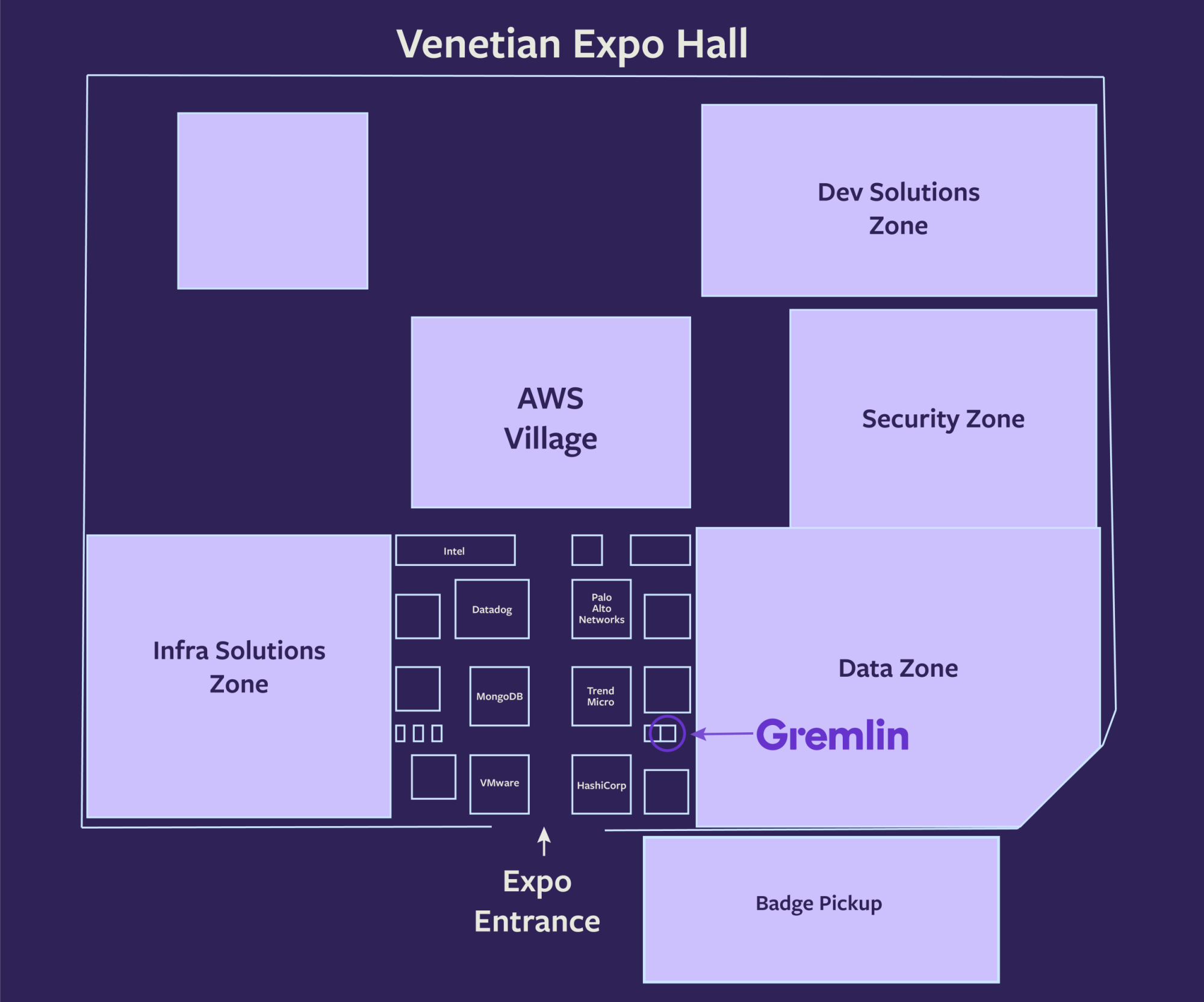AWS re:Invent is right around the corner. The annual largest gathering of cloud enthusiasts and professionals is in Las Vegas from November 27th-December 1st this year—and you can bet that Gremlin’s going to be there!
Over the past year, we’ve released a bunch of new features and improvements to help you increase the reliability of your AWS architecture, including detected risks, reliability management scoring, Failure Flags for serverless testing, additional CloudWatch support, and more.
Stop by the booth for a demo of the latest releases and improvements to help you increase reliability across your AWS architecture.
Read on for the rundown of all things Gremlin at AWS re:Invent 2023!
Where is Gremlin at re:Invent?

AWS re:Invent 2023 spans six different venue hotels, including the Encore, Wynn, Venetian, Caesar’s Forum, MGM Grand, and Mandalay Bay.
You’ll find us at the Venetian Expo in Booth 919.

After you go through the Expo Entrance, we’re to the right near the Data Zone (next to the Hashicorp and Trend Micro booths).
Join Datadog, Redis, PagerDuty, and Gremlin for drinks at Matteo’s

Take a short walk from the expo hall to Restaurant Row in The Venetian to join Datadog, Gremlin, PagerDuty, and Redis for cocktails and conversation at Matteo’s.
Date: Tuesday, November 28th\ Time: 6:00 pm - 8:00 pm
This official re:Invent Restaurant Reception is bound to fill up fast, so register now to save your spot!
Come see what’s new for AWS from Gremlin
Reliability is essential for any AWS architecture—it’s why it’s one of the six pillars of the AWS Well-Architected Framework: “The Reliability pillar encompasses the ability of a workload to perform its intended function correctly and consistently when it’s expected to. This includes the ability to operate and test the workload through its total lifecycle.”
We’ve released a ton of great features over the last year, but here are some highlights of how you can use Gremlin to improve the reliability of your AWS systems:
Use Reliability Management for organization-wide dashboards, scoring, and more
The Gremlin Reliability Management platform makes it easy to find and fix reliability risks at scale on AWS. Initially released in late 2022, it includes a suite of standardized reliability tests so you can quickly start testing for common risks and automate testing on a regular basis.
Over the last year, Reliability Management has seen a host of upgrades, including new dashboards, service catalogs, deeper observability integration, additional automated testing, and more. Stop by and see how it helps you standardized reliability efforts and verify that your system is reliable across the five design principles for reliability in the cloud.
Detect common AWS and Kubernetes risks—no testing required
You might be surprised how many reliability risks there are in the average system. For example, our data shows 26% of deployments have no zone redundancy, and 80% fail to utilize more than two zones. These misconfigurations can have serious impacts on system reliability.
To help make it easy to find them, we introduced Detected Risks in September 2023. Detected Risks are high-priority reliability concerns that Gremlin automatically identifies in your environment without running tests. These risks can include misconfigurations, bad default values, or reliability anti-patterns. It’s like a critical vulnerability scanner—but for reliability.
Ten of the most common risks for Kubernetes are available today, with at least a dozen more planned for release by the end of the year.
Use Failure Flags to run experiments on serverless and more
Gremlin Failure Flags lets you run Chaos Engineering experiments and reliability tests at the application layer on serverless workloads such as AWS Lambda, containers, and similar managed environments.
Just like feature flags, Failure Flags let you perform experiments on specific parts of your services and applications with minimal impact to your application code and no performance impact when disabled. This enables you to test what happens when dependencies go down or slow down, understand how your applications handle unexpected response codes, see behavior when a database is locking, and much more.
Failure Flags are safe to deploy in your application and will default to disabled when you have no actively running experiments. This is an exciting new capability that just entered GA and SDKs are currently available for Node.js, Python, Go, and Java.
But wait, there’s more!
We covered the major AWS-related releases above, but we’ve been busy this year, and it’s only the beginning. There’s plenty of other releases, include Amazon CloudWatch Health Checks, TLS Certificate checks, and more.
You’ll just have to see everything for yourself.
Oh, and if you can’t make it to re:Invent in person, don’t worry! You can attend the event virtually and start a free Gremlin to see how to improve your AWS reliability.


